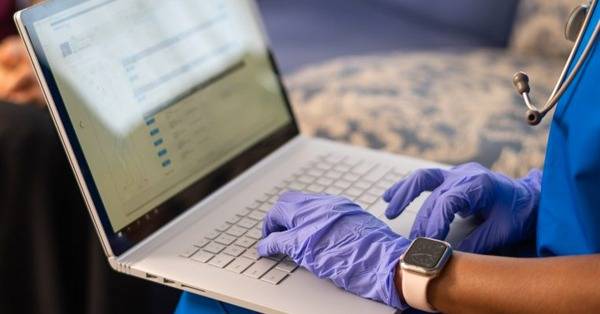- Solutions
- Solutions
- Home Health
- Hospice
- Life Plan Community
- Palliative Care
- Private Duty
- Senior Living
- Skilled Nursing
- Skilled Nursing
- Skilled Nursing Software
- Advanced Insights
- Customer relationship management
- Data and analytics
- Financial & operations management
- Marketing
- Nutrition management
- Referral management
- Regulatory compliance
- Retail management
- Resident engagement
- Revenue cycle management
- Skilled nursing interoperability
- Partners
- Blogs
- Resources
- About
- User Conference

Cyber security: 4 key areas to focus on to keep your SNF’s data safe
What motivates cybercriminals is access to valuable information that can be sold on the black market. As it turns out, medical record data is of the highest value. You may think that the social security number (SSN) or medical record number is all they are after, but that is not the case. Gaining access to insurance information, medication information, and any financial data can provide more return for the criminal than you could imagine. Unfortunately, criminals have been using the COVID19 pandemic as a way to lure unsuspecting users to gain access to this kind of information. Don’t fall victim to common schemes, protect yourself by reading the four things your facility can focus on to stay safe.
Focus on these four areas to keep your SNF safe:
- Operationalize: make cybersecurity part of your business plan
The COVID19 pandemic has forced even more change in business plans and providers see a significant increase in attempted attacks. Cybersecurity may be an oversight, or you may assume the IT team has it covered. However, it’s in your best interest to make sure cybersecurity is called out in your business plan. You must also factor in your third-party vendors and partners and ensure that their policies align with your strategy.
Be sure to assess operational needs using the same methodology as other initiatives: people, process, and technology. The people component may not always be as obvious thanks to new threats emerging from environmental changes. Processes are affected in just about every way, so it is important to look at all processes through the lens of cybersecurity. The most impactful areas for process improvement are those who interact with computers (and other technologies). The threats are also with mobile devices, remote monitoring tools and devices, and any other source where data can be accessed or shared.
- Culture: make education and awareness a priority
To implement an effective cybersecurity strategy, you should ensure the mindset is woven into the culture of the organization. This is especially important since some providers believe that only 50% of their staff take it seriously. If this assumption holds true to your organization, you will want to incorporate cybersecurity as part of your education and awareness plan.
Most providers understand that education is a great investment. For those who have successfully implemented Learning Management Systems (LMS), you have a great start to complement this with education around cybersecurity. Because it is so prevalent, there are many resources and tools available to train your staff. Begin by familiarizing yourself with the key terminology used. This will help you understand the value of the components. Here are some to get you started:
- Malware
- Spyware
- Phishing
- Encryption
- Intrusion detection system (IDS)
- Intrusion prevention system (IPS)
Map out education needs for onboarding, professional training, everyday use of computers, emails, and use of mobile devices. This education does not replace HIPAA training, it is additional (often role-based) education your staff will need. Do your research and make the commitment to invest in education of your staff, they are your greatest asset.
- Become “tech vigilant” by embracing technology
There is a difference between being tech-savvy and tech vigilant. We define tech vigilance as overcoming the vulnerabilities that threatened your business by leveraging technology. It’s a mindset that should be woven into the culture of the organization, starting with the leadership team. So, what does it mean to be tech vigilant?
- Conduct a security assessment for your organization. If outsourcing, be very diligent. Out of hospital providers tend to lag when it comes to cybersecurity best practices, so know that the 3rd party vendors do not necessarily have the experience either. It is a good idea to get a reference from other industries, like hospitals or banks.
- Know the triple A’s
- Acknowledge you are vulnerable
- Anticipate attacks
- Act with vigilance to secure your business
- Be wise and Invest in useful technologies and in security staff.
- Pay attention to front line defenses such as web and email
- Hold all business associates, 3rd parties, and partners accountable. Be cautious and know that the C-suite is a primary target in healthcare.
- Do not overlook Internet-enabled medical devices.
- Obtain cyber liability insurance and be sure to stay abreast while planning for the future.
- Transition to a secure care delivery model: cybersecurity affects your outcome
It goes without saying that providing care is the number one priority for facilities. Because the demand for more efficient care has preoccupied the minds of leaders, the adoption of new technology has been incorporated into care models. Cyber threats prevail even more. Leaders in out of hospital care need to think of their care delivery in a different way. Those who understand cybersecurity have transitioned to a secure care model.
A secure care model is a care delivery approach that will account for the role technology will play, but also builds in security protocols without compromising the quality of care. To accomplish that, leaders must understand the technology threats. Some areas that have been enhanced to ensure a secure care delivery are below:
- Use of email and text
- Clinical documentation
- Mobile charting.
- Remote patient monitoring (RPM)
- Telehealth
- Care coordination portals
Learn more about the MatrixCare security program and adopt some of our strategies.
References:
- https://www.hhs.gov/sites/default/files/covid-19-cyber-threats.pdf
- https://www.hhs.gov/hipaa/for-professionals/security/guidance/cybersecurity/index.html
- https://www.leadingage.org/cast/new-hhs-resource-helps-snfs-increase-cybersecurity
- https://www.leadingage.org/center-aging-services-technologies
- https://www.mcknights.com/marketplace/is-your-long-term-care-cybersecurity-up-to-scratch/
Request a demo today for a closer look at MatrixCare.
See what MatrixCare can do for you
Kevin Whitehurst
Kevin Keith Whitehurst, Senior Vice President, Skilled Nursing Solutions, has been a key player in LTPAC technology since 1990. Whitehurst has held many leadership positions including IT Director for one of the first developers of MDS software systems to, most recently, SVP, Client Services for MatrixCare. In his current role, he is responsible for the success of the Skilled Nursing Solutions Group and oversees Product Management, Professional Services, Sales and Marketing, and Client Support for that group. A 26 year veteran, Whitehurst has dedicated his career to improving Skilled Nursing Providers experience with technology. Whitehurst holds degrees from San Bernardino Valley College and the Los Angeles School of Business and also served in the U.S Air Force.
Related Posts



See MatrixCare in action
Start by having a call with one of our experts to see our platform in action.
MatrixCare offers industry-leading software solutions. Thousands of facility-based and home-based care organizations trust us to help them improve efficiency and provide exceptional care.
© 2025 MatrixCare is a registered trademark of MatrixCare. All rights reserved.





